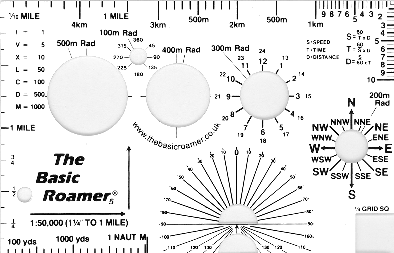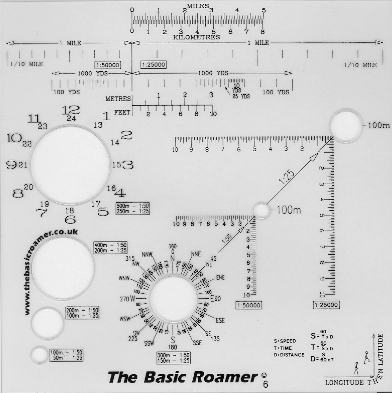|
Copyright © Ray Crowther 2025 |
| When is a Roamer not a Romer? |
| Basic Roamer Press Release | When is Roamer not a Romer? |
|
I was confused at first. I thought the rectangle of white
plastic that I used for plotting map references was called a romer. By
convention it is, but searching all paper and Internet dictionaries I
could find, met with a "word not found". Then I was introduced to a Roamer. Ah, a definition this time: "someone who leads a wandering and unsettled life". Well, a good description of me, but how does that apply to the innovative bits of plastic on my desk describing themselves as Roamers? (The truth of the matter is that the original romer was invented by Lieutenant Carrol Romer of the First Army's Maps and Printing Section of the Royal Engineers in the First World War. Roamer is a subtle renaming by The Basic Roamer Company who have copyrighted the name.) But who needs to be concerned with semantics? Let me get on with the real subject matter of this article. For over 30 years I've used a romer (not the same one - I've lost a few and worn out many), but this old dog has been taught a new trick, and from now on I'll be using a Roamer - The Basic Roamer. This is not a new product, but has recently been relaunched, though I'll pass on the history lesson just now. The image below says most of it.
Yes, another plastic thingee for plotting map references, but with some extraordinarily handy and contemporary extras. Regretfully, long gone are the days when road rallies could have straightforward navigation, and the results were decided by pruned watches, targa timing and odometers that mysteriously recorded only half the actual route distance. Now, a navigator needs a huge briefcase or handbag of navigational aids; so something small and versatile is just the job. Enter The Basic Roamer 5. Let me start with the prime use: plotting map references. Three main
requirements come to mind: 1) durability 2) accuracy and 3) convenience. The Roamer 5 has lots of cut-outs, which make it bendy, but useful. (I did tempt fate and bend the plastic through 180 degrees and ... the plastic based paint stayed perfectly formed.) The all important neck cord hole is bottom left and elsewhere there are holes of radius 100m, 200m, 300m, 400m and 500m. The 100m hole reminds us of degrees of angle (in 45 degree graduations) and the 300m hole is encircled with a 12 hour and 24 hour clock face. The 200m radius cut-out hole is circled with the 16 prime compass directions which, if you are longitudinally dyslexic like me, will jog your memory about east and west. The bottom right has a 1/4 grid square cut-out - great for marking those mini Quiet Zones. Bottom left is a nautical mile scale pecked at 100 yard intervals. Not sure whether this is permitted by EU metric measurement directives, but its there if you need it. Squeezed in near the bottom edge is a protractor with a range of clockwise and anti-clockwise angles at 10 degree intervals to 130 degrees and two semi-circular cut-outs. I'm not convinced how useful this is, other than perhaps as an aide memoire of angles if you are not too good at judging them by eye. I haven't grasped the reason for the cut-outs, and rather than having anti-clockwise angles of 0 to 130, clockwise angles of 230 to 360 would be more practical. There's still more gadgets crammed onto the Roamer 5. Top left is a handy reference of roman numerals and top right are the formulae for time, speed and distance calculations, though they intrude a tad on the grid square plotting edges. Finally the design of the Basic Roamer logo arrows remind us that we plot a map reference "along the corridor" then "up the stairs". If you get stuck with any of this the Roamer comes with a detailed instruction leaflet. So all in all The Basic Roamer 5 is not at all basic. Its full of natty features to satisfy the most discerning navigator. I turned the Roamer over and was disappointed the white space hadn't been used. There's ample room for average speed tables, an OS map legend and a list of all the Give Ways junctions in Essex - perhaps that will come in subsequent revisions! There are in fact three versions of The Roamer 5. I've talked about the black on white edition, but you can get red on white too. I preferred the monochrome version which my aging vision could cope with better. The third uses black printing on clear plastic. I found it more difficult to plot a reference with this because I thought the see-through detail was intrusive. It did, however, make the protractor easier to use since the transparency was essential to align the angle lines. At £5 post free, (discounted on orders of five or more) the Roamer 5 is a bargain and an absolute must for rallying. Mine already has a neck cord attached ready to do battle with the next route card thrust through the navigator's window. If you are a two-footed competitor rather than the four-wheeled variety, the Basic Roamer 6 will suit you better.
Aimed more at trekkers using 1:25000 Explorer maps, the "6" is about 50% larger than the "5" and only comes in a clear plastic version. Not ideal for road rally folk (though I believe it has found favour with some co-drivers on stage events, who have nicknamed it the Forest Roamer), but its protractor would be worthy of transplanting to the "5". The Basic Roamer Company website is at http://thebasicroamer.co.uk.
"Crow" |
|
|


